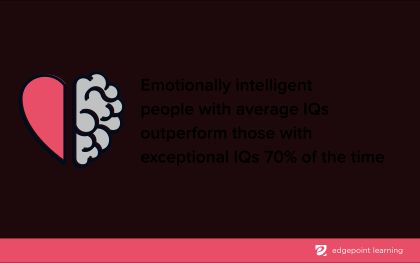How To Develop Emotional Intelligence Training For Employees
Corey Bleich
🍿 5 min. read
Imagine a workplace where employees feel valued and grounded. They know that they are part of a larger mission, working with others to create a space where even the most diametrically opposed people can come together and build consensus. If this sounds like a magical, mythical place, don’t despair. Emotional intelligence training for employees can help you get there. This is how.
What is emotional intelligence and how can it be used in the workplace?
Psychology Today defines emotional intelligence as the ability to manage not only your own emotions but also the emotions of others. This includes three separate skills:
- Identifying and naming emotions
- Applying emotions to problem solving when necessary
- Regulating your own emotions and knowing when to help regulate the emotions of others
These emotional intelligence skills can come into play in virtually every industry. In the most basic example, think of healthcare providers who are working with families of chronically or terminally ill people. Emotionally intelligent employees will be better able to meet the needs of the patients and their families than those who do not really understand how to regulate their own emotions (or problem solve when emotions run high).
In other settings, such as on a jobsite, emotional intelligence can help employees identify the real underlying issues when they are working, rather than being swept away by anger or frustration. It can also be especially beneficial for teachers and your front-line managers.
Emotional intelligence in the workplace is one of a number of soft skills that make employees better at their jobs (and more satisfied in them!).
What are the benefits of emotional intelligence in the workplace?
By 2025, 75% of the workforce will be millennials. These employees are tech savvy, appreciate socially aware companies, and are focused on mindfulness in their employment. Millennials are looking for a company that values them. They want to know that their employers are emotionally intelligent enough to help them grow not just as employees but also as people.
As an employer, you want that, too.
Emotionally intelligent people with average IQs outperform people with exceptional IQs 70% of the time. Why? Because emotionally intelligent employees have a high dose of two important skills: personal competence and social competence.

Personally competent employees do not go off the rails whenever something disappointing happens. They show resilience and an ability to persist in the face of personal challenges.
Indeed, these same employees also demonstrate a higher level of social competence. They are able to “read the room” for better communication and understanding. They know how to manage this information to successfully interact with people from all walks of life (and in every kind of mood).
Emotional intelligence skills are difficult to measure and challenging to teach, but it can be done. The benefits of emotional intelligence in the workplace may include:
- Financial gain for employees: People with well-developed emotional intelligence may earn up to nearly $30,000 more a year than those without them
- Personal accomplishment: 58% of your job success is based on EI (emotional intelligence)
- Success for your company: Of top performers, 90% have a high EI
If you aren’t sure where to start, keep reading.

How to develop emotional intelligence training for employees
Developing emotional intelligence training for employees is unlike other types of trainin. There is a qualitative component to this type of training you must consider from the very start.
No one wants to hear that they are not emotionally intelligent, so there is skill that begins at planning and runs all the way through to evaluation of the training itself.
1. Get buy in from the top
Perhaps more than any other type training, you need executive endorsement from the very beginning. Help the folks in charge understand why emotionally intelligent employees are the best kind.
Give them the stats on the benefits of emotional intelligence in the workplace, and lay out your plan for success.
2. Measure current emotional intelligence
Every good emotional intelligence training for employees begins with an understanding of where everyone is starting. There are a number of assessments you can use to determine a good jumping off point.
These include:
- MSCEIT: This test measures emotional intelligence in the same way an IQ test measures cognitive intelligence
- EQ-i: The EQ-i looks at present emotional intelligence traits
- ESCI: Based on competency, an employee’s score will differ on their experience
- Genos: This behavioral test measures how often an employee demonstrates emotionally intelligent behavior
It’s not necessary to administer four tests to begin. The MSCEIT is a good place to start and can give you an overall understanding of your employees’ emotional intelligence skills. Because emotional intelligence can be learned, it's important to identify a baseline so you can measure progress going forward.
3. Design your comprehensive training
Emotional intelligence training for employees must include the following four domains of development:
- Self-awareness
- Self-management
- Social awareness
- Relationship management
These can be trained most effectively through experiences and interactions. Simple things like selecting a company-wide book on emotional intelligence and holding discussion groups or giving employees regular time to volunteer can help develop all four domains.
Other idea for developing emotional intelligence skills include:
- Teaching meditation for self-management
- Promoting and developing better listening skills for social awareness and relationship management
- Developing team-building activities that foster empathy and promote better understanding of others
- Developing a shared work culture that is diverse, inclusive, and supportive
- Updating your workplace to create space for collaboration and a warmer, more comfortable environment
- Helping employees understand (and implement) their best work style
Trainings can also include online check-ins or microlearning modules that include questions to think about or reminders to reflect on what is happening right at that moment.
Even a push notification that tells employees to do a quick ten-second scan of their emotional landscape and frame of mind can improve emotional intelligence skills. A good variety of TED talks on emotional intelligence can also be part of your training.
4. Evaluate your training
You can easily evaluate the success of your emotional intelligence training for employees by offering one of the EI tests from above and then testing at subsequent points after employees have taken the training. In many cases, though, the success of your training will be apparent right as you walk through the office.
At EdgePoint Learning, we understand that emotional intelligence training for employees can be challenging to design. Get in touch today and let us know how we can help!
